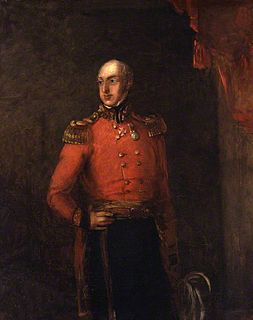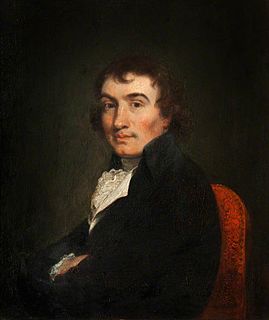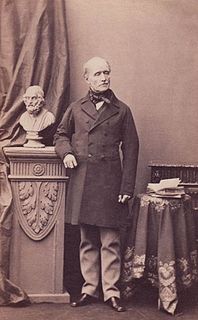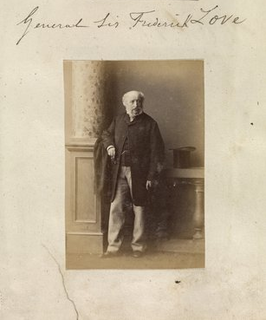General George Whichcote (1794 - 26 August 1891) was a senior officer in the British Army.
He was born the fourth son of Thomas Whichcote, 5th Baronet of Aswarby Park, Lincolnshire. After attending Rugby School he enlisted as a volunteer in the 52nd (Oxfordshire) Regiment of Foot and received a commission as an ensign in 1811.

Aswarby is a village in the North Kesteven district of Lincolnshire, England. It is 3.5 miles (5.6 km) south of Sleaford and 750 yards (690 m) east of the A15 road, between Sleaford and the point near Threekingham where it crosses the A52 road.
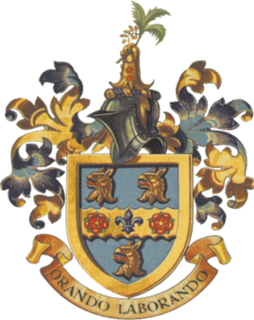
Rugby School is a day and mostly boarding co-educational independent school in Rugby, Warwickshire, England. Founded in 1567 as a free grammar school for local boys, it is one of the oldest independent schools in Britain. Up to 1667, the school remained in comparative obscurity. Its re-establishment by Thomas Arnold during his time as Headmaster, from 1828 to 1841, was seen as the forerunner of the Victorian public school. It is one of the original seven Great Nine Public Schools defined by the Clarendon Commission of 1864. Rugby School was also the birthplace of Rugby football. In 1845, a committee of Rugby schoolboys wrote the "Laws of Football as Played At Rugby School", the first published set of laws for any code of football.

The 52nd (Oxfordshire) Regiment of Foot was a light infantry regiment of the British Army throughout much of the 18th and 19th centuries. The regiment first saw active service during the American War of Independence, and were posted to India during the Anglo-Mysore Wars. During the Napoleonic Wars, the 52nd were part of the Light Division, and were present at most of the major battles of the Peninsula campaign, becoming one of the most celebrated regiments, described by Sir William Napier as "a regiment never surpassed in arms since arms were first borne by men". They had the largest British battalion at Waterloo, 1815, where they formed part of the final charge against Napoleon's Imperial Guard. They were also involved in various campaigns in India.
That same year he sailed on HMS Pompee to join the British army in the Spanish peninsula, where his regiment, together with the 43rd and the 95th regiments, formed the Light Division. After taking part in the Battle of Sabugal in April and in the Battle of El Bodón in September he assisted in the siege of Ciudad Rodrigo and the Battle of Badajoz in 1812. Made a lieutenant in July he was present at the battles of Battle of Salamanca and Vittoria, where the 52nd carried the village of Magarita. He took part with his regiment in the combats in the Pyrenees in July and August, the Battle of Vera in October, the Battle of Nivelle in November, the Battle of the Nive in December, the Battle of Orthes in February, 1814 and the fighting at Tarbes in March. At the final Battle of Toulouse in April, he was the first man in the British army to enter the town when, having observed the French retreat when in command of an advanced picket, he pressed on to take possession of the town. At the end of the war the regiment was put on garrison duty at Castelsarrasin on the Garonne, and afterwards was sent to Ireland.

HMS Pompee was a 74-gun ship of the line of the British Royal Navy. Built as La Pompée, a Téméraire class ship of the French Navy, she was handed over to the British at Spithead by French royalists who had fled France after the Siege of Toulon by the French Republic, only a few months after being completed. After reaching Great Britain, La Pompée was registered and recommissioned as HMS Pompee and spent the entirety of her active career with the Royal Navy until she was broken up in 1817.

The Battle of Sabugal was an engagement of the Peninsular War which took place on 3 April 1811 between Anglo-Portuguese forces under Arthur Wellesley and French troops under the command of Marshal André Masséna. It was the last of many skirmishes between Masséna's retreating French forces and those of the Anglo-Portuguese under Wellington, who were pursuing him after the failed 1810 French invasion of Portugal.

The Battle of El Bodón was fought on 25 September 1811 by elements of the Anglo-Portuguese army and elements of the French army during the Peninsular War.
Whichcote then took part in the Battle of Waterloo, where the 52nd completed the rout of the Imperial Guard. When the 52nd was afterwards ordered to Botany Bay, Whichcote exchanged into the Buffs. In 1818 he was promoted captain, and in 1822 exchanged into the 4th Dragoon Guards, where was made major in 1825, lieutenant-colonel in 1838, and colonel in 1851. In 1825 he was placed on half-pay and made major-general, promoted to lieutenant-general in 1864, and full general on 5 December 1871.
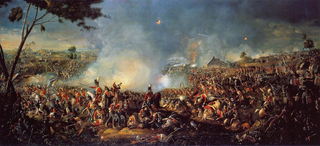
The Battle of Waterloo was fought on Sunday, 18 June 1815 near Waterloo in Belgium, part of the United Kingdom of the Netherlands at the time. A French army under the command of Napoleon Bonaparte was defeated by two of the armies of the Seventh Coalition: an army consisting of units from Britain, Ireland, the German Legion, the Netherlands, Hanover, Brunswick and Nassau, under the command of the Duke of Wellington, referred to by many authors as the Anglo-allied army, and a Prussian army under the command of Field Marshal Blücher. The battle marked the end of the Napoleonic Wars.

The Imperial Guard was originally a small group of elite soldiers of the French Army under the direct command of Napoleon I, but grew considerably over time. It acted as his bodyguard and tactical reserve, and he was careful of its use in battle. The Guard was divided into the staff, infantry, cavalry, and artillery regiments, as well as battalions of sappers and marines. The guard itself as a whole distinguished between the experienced veterans and less experienced members by being separated into three sections: the Old Guard, Middle Guard and Young Guard.

Botany Bay, an open oceanic embayment, is located in Sydney, New South Wales, Australia, 13 km (8 mi) south of the Sydney central business district. Its source is the confluence of the Georges River at Taren Point and the Cooks River at Kyeemagh, which flows 10 km (6 mi) to the east before meeting its mouth at the Tasman Sea, midpoint between La Perouse and Kurnell.
He died on 26 August 1891 at Meriden, near Coventry, where he had resided since retiring from active service, and was buried in St Laurence's churchyard there on 31 August, one of the two surviving officers of the English army who had been present at Waterloo. In 1842 he had married Charlotte Sophia, the daughter of Philip Monckton. They had no children.



